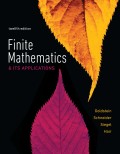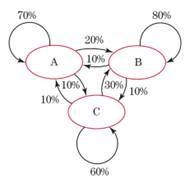
Concept explainers
Car Rentals The Day-by-Day car rental agency rents cars only on a daily basis. Rented cars can be returned at the end of the day to any of the agency’s three locations—-A, B, or C. Figure 4 shows the percentages of cars returned to each of the locations on the basis of where they were picked up. Assume that all of the agency’s cars are rented each day and that, initially, 40% of the cars are at location A, 30% at location B, and 30% at location C.

Figure 4
a. Set up the stochastic matrix that displays these transitions.
b. Use the matrix from part (a) to estimate the percentage of the cars at location A after one day. After two days.
c. In the long run, what fraction of the cars will be at each location?
Want to see the full answer?
Check out a sample textbook solution
Chapter 8 Solutions
Finite Mathematics & Its Applications (12th Edition)
Additional Math Textbook Solutions
Finite Mathematics for Business, Economics, Life Sciences and Social Sciences
Elementary Statistics
Probability And Statistical Inference (10th Edition)
Elementary Statistics (13th Edition)
Elementary Statistics: A Step By Step Approach
Beginning and Intermediate Algebra
- Find the complete set of values of the constant c for which the cubic equation 2x³-3x²-12x + c = 0 has three distinct real solutionsarrow_forwardCan you tell me if I answered and showed my work correctlyarrow_forwardLO 2 -5 -4 -3 -2 0 --1- 2 + -5 Which system is represented in the graph? + LO 5 Xarrow_forward
- > co LO -6 -5 -4 4 do 3 3 2 1 Τ O 1 3 4 5 --6- -CO 6arrow_forward3.12 (B). A horizontal beam AB is 4 m long and of constant flexural rigidity. It is rigidly built-in at the left-hand end A and simply supported on a non-yielding support at the right-hand end B. The beam carries Uniformly distributed vertical loading of 18 kN/m over its whole length, together with a vertical downward load of 10KN at 2.5 m from the end A. Sketch the S.F. and B.M. diagrams for the beam, indicating all main values. Cl. Struct. E.] CS.F. 45,10,376 KN, B.M. 186, +36.15 kNm.7arrow_forwardDraw the isoclines with their direction markers and sketch several solution curves, including the curve satisfying the given initial conditions. 1) y'=x + 2y ; y(0) = 1 and 2) y' = x², y(0)=1arrow_forward
- Qize f(x) = x + 2x2 - 2 x² + 4x²² - Solve the equation using Newton Raphsonarrow_forward-b±√√b2-4ac 2a @4x²-12x+9=0 27 de febrero de 2025 -b±√√b2-4ac 2a ⑥2x²-4x-1=0 a = 4 b=-12 c=9 a = 2 b = 9 c = \ x=-42±√(2-4 (4) (9) 2(4)) X = (12) ±√44)-(360) 2(108) x = ±√ X = =±√√²-4(2) (1) 2() X = ±√ + X = X = + X₁ = = X₁ = X₁ = + X₁ = = =arrow_forwardx/x-2 + 3/x-4arrow_forward
- part barrow_forwardConsider the following model of a population in continuous time. N(t) = rN(t)e¯ß³N(t), r > 0,ẞ> 0. (1) (a) Without solving the equation, determine an upper bound for N(t) in terms of the initial popu- lation No, and the parameters ẞ and r.arrow_forwardQ1: A: Let M and N be two subspace of finite dimension linear space X, show that if M = N then dim M = dim N but the converse need not to be true. B: Let A and B two balanced subsets of a linear space X, show that whether An B and AUB are balanced sets or nor verly A:LeLM be a subset of a linear space X, show that M is a hyperplane of X iff there exists fe X'/[0] and a EF such that M = {x Ex/f(x) = = a}. B:Show that every two norms on finite dimension linear space are equivalent C: Let f be a linear function from a normed space X in to a normed space Y, show that continuous at x, EX iff for any sequence (x) in X converge to x, then the sequence (f(x)) converge to (f(x)) in Y.arrow_forward
 Holt Mcdougal Larson Pre-algebra: Student Edition...AlgebraISBN:9780547587776Author:HOLT MCDOUGALPublisher:HOLT MCDOUGAL
Holt Mcdougal Larson Pre-algebra: Student Edition...AlgebraISBN:9780547587776Author:HOLT MCDOUGALPublisher:HOLT MCDOUGAL Glencoe Algebra 1, Student Edition, 9780079039897...AlgebraISBN:9780079039897Author:CarterPublisher:McGraw Hill
Glencoe Algebra 1, Student Edition, 9780079039897...AlgebraISBN:9780079039897Author:CarterPublisher:McGraw Hill Big Ideas Math A Bridge To Success Algebra 1: Stu...AlgebraISBN:9781680331141Author:HOUGHTON MIFFLIN HARCOURTPublisher:Houghton Mifflin Harcourt
Big Ideas Math A Bridge To Success Algebra 1: Stu...AlgebraISBN:9781680331141Author:HOUGHTON MIFFLIN HARCOURTPublisher:Houghton Mifflin Harcourt Functions and Change: A Modeling Approach to Coll...AlgebraISBN:9781337111348Author:Bruce Crauder, Benny Evans, Alan NoellPublisher:Cengage Learning
Functions and Change: A Modeling Approach to Coll...AlgebraISBN:9781337111348Author:Bruce Crauder, Benny Evans, Alan NoellPublisher:Cengage Learning



